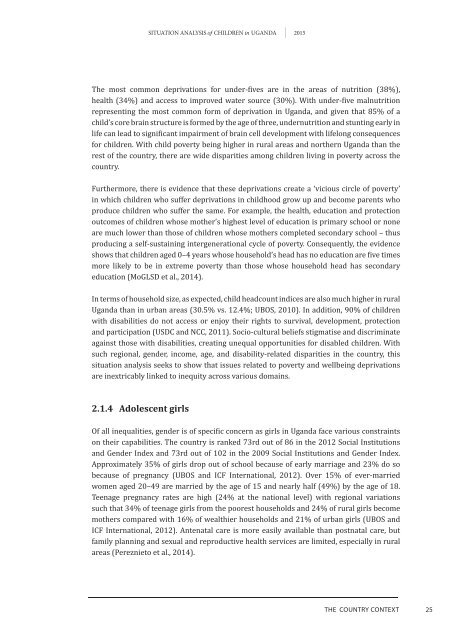Situation analySiS
1TNu802
1TNu802
Create successful ePaper yourself
Turn your PDF publications into a flip-book with our unique Google optimized e-Paper software.
<strong>Situation</strong> <strong>analySiS</strong> of Children in uganda 2015The most common deprivations for under-fives are in the areas of nutrition (38%),health (34%) and access to improved water source (30%). With under-five malnutritionrepresenting the most common form of deprivation in Uganda, and given that 85% of achild’s core brain structure is formed by the age of three, undernutrition and stunting early inlife can lead to significant impairment of brain cell development with lifelong consequencesfor children. With child poverty being higher in rural areas and northern Uganda than therest of the country, there are wide disparities among children living in poverty across thecountry.Furthermore, there is evidence that these deprivations create a ‘vicious circle of poverty’in which children who suffer deprivations in childhood grow up and become parents whoproduce children who suffer the same. For example, the health, education and protectionoutcomes of children whose mother’s highest level of education is primary school or noneare much lower than those of children whose mothers completed secondary school – thusproducing a self-sustaining intergenerational cycle of poverty. Consequently, the evidenceshows that children aged 0–4 years whose household’s head has no education are five timesmore likely to be in extreme poverty than those whose household head has secondaryeducation (MoGLSD et al., 2014).In terms of household size, as expected, child headcount indices are also much higher in ruralUganda than in urban areas (30.5% vs. 12.4%; UBOS, 2010). In addition, 90% of childrenwith disabilities do not access or enjoy their rights to survival, development, protectionand participation (USDC and NCC, 2011). Socio-cultural beliefs stigmatise and discriminateagainst those with disabilities, creating unequal opportunities for disabled children. Withsuch regional, gender, income, age, and disability-related disparities in the country, thissituation analysis seeks to show that issues related to poverty and wellbeing deprivationsare inextricably linked to inequity across various domains.2.1.4 Adolescent girlsof all inequalities, gender is of specific concern as girls in Uganda face various constraintson their capabilities. The country is ranked 73rd out of 86 in the 2012 Social Institutionsand Gender Index and 73rd out of 102 in the 2009 Social Institutions and Gender Index.Approximately 35% of girls drop out of school because of early marriage and 23% do sobecause of pregnancy (UBOS and ICF International, 2012). Over 15% of ever-marriedwomen aged 20–49 are married by the age of 15 and nearly half (49%) by the age of 18.Teenage pregnancy rates are high (24% at the national level) with regional variationssuch that 34% of teenage girls from the poorest households and 24% of rural girls becomemothers compared with 16% of wealthier households and 21% of urban girls (UBOS andICF International, 2012). Antenatal care is more easily available than postnatal care, butfamily planning and sexual and reproductive health services are limited, especially in ruralareas (Pereznieto et al., 2014).thE CoUNtry CoNtExt25




